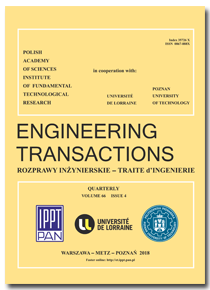10.24423/EngTrans.2241.20221116
Detection of the Presence of Rail Corrugation Using Convolutional Neural Network
Rail corrugation is a significant problem not only in heavy-haul freight but also in light rail systems. Over the last years, considerable progress has been made in understanding, measuring and treating corrugation problems also considered a matter of safety.
In the presented research, convolutional neural networks (CNNs) are used to identify the occurrence of rail corrugation in light rail systems. The paper shows that by simultaneously measuring the vibration and the sound pressure, it is possible to identify the rail corrugation with a very small error.
References
EN 13231-3:2012, Railway applications. Track. Acceptance of works. Acceptance of reprofiling rails in track.
Bednarek W., Railroad corrugation (causes and countermeasures) [in Polish: Zużycie faliste szyn toru kolejowego (przyczyny i środki zaradcze)], Archiwum Instytutu Inżynierii Lądowej, (2015): 7–23, 2015.
Grassie S.L., Corrugation on Australian National: cause, measurement and rectification, [in:] Proceedings of the Fourth International Heavy Haul Railway Conference 1989: Railways in Action, Brisbane, Australia, pp. 188–192, 1989.
Oostermeijer K.H., Review on short pitch rail corrugation studies, Wear, 265(9–10): 1231–1237, 2008, doi: 10.1016/j.wear.2008.01.037.
Grassie S.L., Corrugation: variations on an enigma, Railway Gazette International, 146 (7): 531–533, 1990.
Grassie S.L., Kalousek J., Rail corrugation: characteristics, causes and treatments, Proceedings of the Institution of Mechanical Engineers, Part F: Journal of Rail and Rapid Transit, 207(1): 57–68, 1993, doi: 10.1243/PIME_PROC_1993_207_227_02.
Grassie S.L., Rail corrugation: advances in measurement, understanding and treatment, Wear, 258(7–8): 1224–1234, 2005, doi: 10.1016/j.wear.2004.03.066.
Grassie S.L., Rail corrugation: characteristics, causes, and treatments, Proceedings of the Institution of Mechanical Engineers, Part F: Journal of Rail and Rapid Transit, 223(6): 581–596, 2009, doi: 10.1243/09544097JRRT264.
Sato Y., Matsumoto A., Knothe K., Review on rail corrugation studies, Wear, 253(1–2): 130–139, 2002, doi: 10.1016/S0043-1648(02)00092-3.
Ishida M., Moto T., Takikawa M., The effect of lateral creepage force on rail corrugation on low rail at sharp curves, Wear, 253(1–2): 172–177, 2002, doi: 10.1016/S0043-1648(02)00096-0.
Suda Y., Hanawa M., Okumura M., Iwasa T., Study on rail corrugation in sharp curves of commuter line, Wear, 253(1–2): 193–198, 2002, doi: 10.1016/S0043-1648(02)00096-0.
Liu Q.Y., Zhang B., Zhou Z.R., An experimental study of rail corrugation, Wear, 255(7–12): 1121–1126, 2003, doi: 10.1016/S0043-1648(03)00213-8.
Fink M., The emergence of the rail corrugation; The status of corrugation research after around 60
years [in German: Die Entstehung der Schienriffeln; Der Stand der Riffelforschung nach rund 60 Jahren] (part 1 of 2), Glasers Annalen, No. 11: 342–350, 1953.
Wei X., Yin X., Hu Y., He Y. & Jia L., Squats and corrugation detection of railway track based on time-frequency analysis by using bogie acceleration measurements, Vehicle System Dynamics, 58(8): 1167–1188, 2020, doi: 10.1080/00423114.2019.1610181.
Lang K., Xing Z., Dong W., Gao X., A rail corrugation detection method based on wavelet packet energy entropy, [in:] Jia L., Qin Y., Suo J., Feng J., Diao L., An M. [Eds.], Proceedings of the 3rd International Conference on Electrical and Information Technologies for Rail Transportation (EITRT) 2017. EITRT 2017. Lecture Notes in Electrical Engineering, vol. 483, Springer, Singapore, 2018; doi: 10.1007/978-981-10-7989-4_21.
Li J., Shi H., Rail corrugation detection of high-speed railway using wheel dynamic responses, Shock and Vibration, 2019: Article ID 2695647, 12 pages, 2019, doi, 10.1155/2019/2695647.
Zhang H., Wang N., Song L.I.U. et al., Rail corrugation identification method based on parameter optimization VMD and SPWVDJ, Railway Computer Application, 29(6): 18–24, 2020.
Xiao B., Liu J., Zhang Z., A heavy-haul railway corrugation diagnosis method based on WPD-ASTFT and SVM, Shock and Vibration, 2022: Article ID 8370796, 14 pages, 2022, doi: 10.1155/2022/8370796.
Kang G., Li C., Qin L., Rail corrugation detection method based on laser imaging technology, Urban Mass Transit, 10(181): 94–97+111, 2017.
Li P., Wang P., Chen P., Rail corrugation detection based on 3D structured light and wavelet analysis, Railway Standard Design, 062(008): 33–38, 2018.
Feng J.H., Yuan H., Hu Y.Q., Lin J., Liu S.W., Luo X., Research on deep learning method for rail surface defect detection, IET Electrical Systems in Transportation, 10(4): 436–442, 2020, doi: 10.1049/iet-est.2020.0041.
Gorges C., Öztürk K., Liebich R., Impact detection using a machine learning approach and experimental road roughness classification, Mechanical Systems and Signal Processing, 117: 738–756, 2019, doi: 10.1016/j.ymssp.2018.07.043.
Lei Y., He Z., Zi Y., Application of an intelligent classification method to mechanical fault diagnosis, Expert Systems with Applications, 36(6): 9941–9948, 2009, doi: 10.1016/j.eswa.2009.01.065.
Mechefske C.K., Mathew J., Fault detection and diagnosis in low speed rolling element bearings Part II: The use of nearest neighbour classification, Mechanical Systems and Signal Processing, 6(4): 309–316, 1992, doi: 10.1016/0888-3270(92)90033-F.
Firlik B., Tabaszewski M., Monitoring of the technical condition of tracks based on machine learning, Proceedings of the Institution of Mechanical Engineers, Part F: Journal of Rail and Rapid Transit, 234(7): 702–708, 2020, doi: 10.1177/0954409719866368.
Tsunashima H., Condition monitoring of railway tracks from car-body vibration using a machine learning technique, Applied Sciences, 9(13): 27–34, 2019, doi: 10.3390/app9132734.
Sysyn M., Gruen D., Gerber U., Nabochenko O., Kovalchuk V., Turnout monitoring with vehicle based inertial measurements of operational trains: a machine learning approach, Communications – Scientific Letters of the University of Zilina, 21(1): 42–48, 2019, doi: 10.26552/com.C.2019.1.42-48.
Géron A., Hands-on Machine Learning with Scikit-Learn, Keras and TensorFlow, O’Reilly Media, 2017.
Sarker G., Some studies on convolution neural network, International Journal of Computer Applications, 182(21): 13–22, 2018, doi: 10.5120/ijca2018917965.
Chen R., Huang X., Yang L., Xu X., Zhang X., Zhang Y., Intelligent fault diagnosis method of planetary gearboxes based on convolution neural network and discrete wavelet transform, Computers in Industry, 106: 48–59, 2019, doi: 10.1016/j.compind.2018.11.003.
Jia F., Lei Y., Lu N., Xing S., Deep normalized convolutional neural network for imbalanced fault classification of machinery and its understanding via visualization, Mechanical Systems and Signal Processing, 110: 349–367, 2018, doi: 10.1016/j.ymssp.2018.03.025.
Korbicz J., Kościelny J.M., Kowalczuk Z., Cholewa W., Fault Diagnosis: Models, Artificial Intelligence, Applications, Springer Science & Business Media, Berlin Heidelberg, 2004, doi: 10.1007/978-3-642-18615-8.
DOI: 10.24423/EngTrans.2241.20221116





